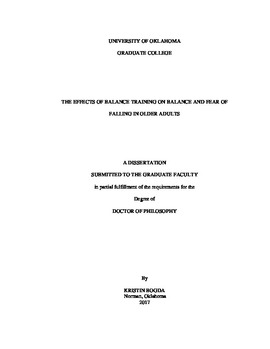| dc.description.abstract | The purposes of this study were to determine (1) the effects of a 6-week balance training intervention on balance and fear of falling in older adults and (2) to evaluate the effects of a 6-week behavioral intervention on adherence to balance exercises and number of falls. Balance was measured using the NeuroCom Balance Master®, the Timed Up and Go, and the Timed Walk tests. Fear of falling was measured using the Falls Efficacy Scale. Twenty-three participants were recruited for this study and were assigned to one of two groups, an intervention group (18) and a control group (5). The balance intervention was provided to the intervention group and were conducted for one hour three times a week for six weeks. After completion of the balance intervention, the intervention group participated in a behavioral intervention, where they were randomly assigned to one of two groups, an intervention group (9) and a control group (9). Participants in the intervention group for the behavioral intervention received encouragement and guidance to continue practicing the balance exercises through emails and phone calls. The control group received no phone calls or emails during this period, but were asked to continue practicing the balance exercises.
A two-way repeated measures ANOVA for time (pre-test, post-test, follow-up) and group (intervention and control) were conducted to evaluate the time and group main effects and time*group interaction for all the outcome variables in order to assess change related to participation in the balance training intervention (pre- to post-test) and the behavioral intervention (post- to follow-up). The results indicated that participation in the balance training intervention significantly improved some balance measures and significantly decreased fear of falling. Participation in the behavioral intervention was associated with maintenance of balance measures and the fear of falling measure and balance exercise adherence rate when the intervention group was compared to the control group. Future research is advised to further explore the best balance exercises for older adults as well as the best balance measures for older adults.
Keywords: Balance, Older Adults, Fall Prevention, Fear of Falling | en_US |
